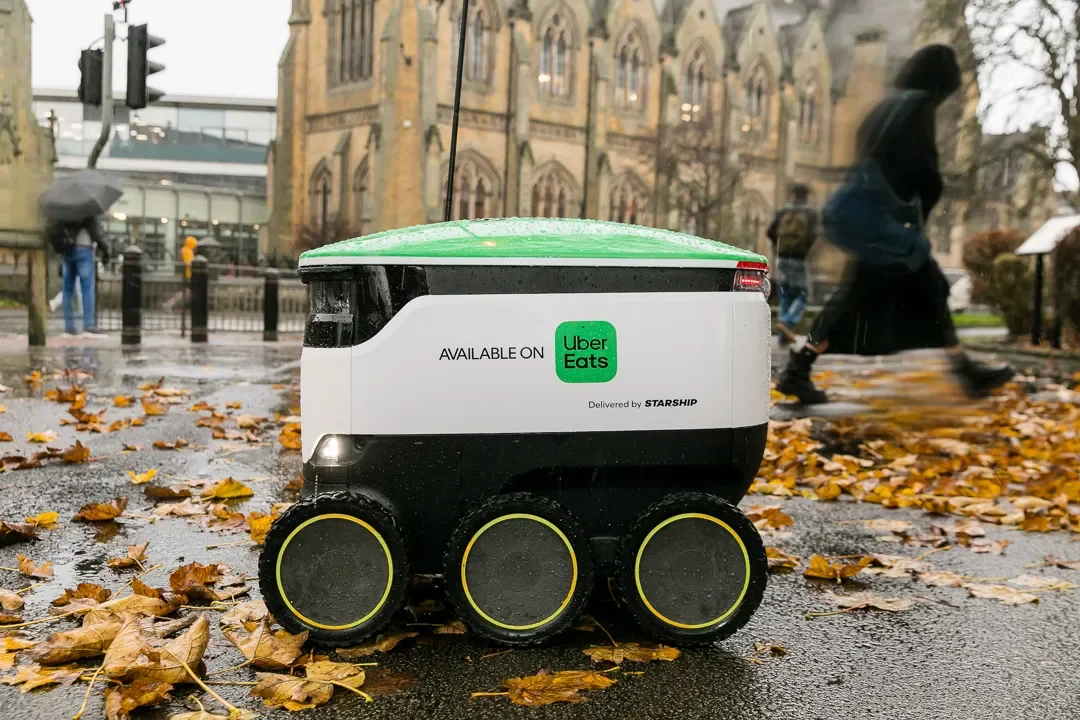Uber Eats Taps Starship’s Six-Wheeled Robots for UK Deliveries
Uber Eats is preparing to introduce a very different kind of courier to the streets of the United Kingdom. Beginning this December, customers in Leeds and later Sheffield will start receiving food and small-item deliveries from Starship Technologies’ autonomous, six-wheeled sidewalk robots. The partnership marks a significant milestone for both companies and sets the stage for a far wider rollout—Europe in 2026 and the United States in 2027—reflecting how quickly autonomous logistics is moving from novelty to infrastructure.
Starship’s robots are already an everyday presence in certain parts of the UK, quietly navigating pavements and crossing roads as they ferry goods to neighborhoods and campuses. What many don’t see is the scale behind the operation. Starship runs what it calls the world’s largest autonomous delivery network, deploying more than 2,700 robots across 270 locations and completing over 100,000 road crossings each day. The company has accumulated an enormous dataset—roughly 200 million crossings—that continuously feeds its AI models, helping refine how the robots perceive and respond to the world around them. This makes the partnership with Uber Eats not just a business arrangement, but a deeper integration of autonomy into the rhythms of urban life.
When the service launches, customers won’t be able to tip their robot courier, but they can rate the experience in the app just as they would with any human delivery driver. While playful on the surface, this reflects a broader question that the delivery industry is starting to confront: what does customer feedback look like when the courier has no emotions, and the experience becomes a measure of pure efficiency?
The move also aligns with Uber’s wider strategy to embrace autonomy across continents. In the U.S., Uber Eats already partners with several robotics companies—Serve Robotics, Avride, and others—operating in major cities such as Los Angeles, Miami, Chicago, Austin, and Atlanta. Pilots are underway in Tokyo and Osaka, and the company shows no signs of slowing its expansion. For Uber, robot delivery represents both a technological ambition and a practical one: autonomy promises lower costs, faster delivery times, and new ways of scaling operations without relying solely on human labor.
Starship sees the partnership in equally transformative terms. Ahti Heinla, the company’s co-founder and CEO, emphasized that the two firms are “building the infrastructure that will define the next generation of urban logistics,” noting how Uber brings global reach while Starship contributes proven autonomy at city scale. It’s a pairing of platform and mobility—one built on the idea that delivery can be reimagined through thousands of small, durable machines moving steadily along the urban landscape.
Uber Eats’ Global Head of Autonomous, Sarfraz Maredia, echoed that sentiment, calling autonomous delivery a key part of the company’s future vision. By partnering with Starship, Uber aims to bring robot delivery not just to a few demonstration neighborhoods but across multiple continents, reshaping the economics and expectations of last-mile logistics.
As Leeds and Sheffield prepare to welcome their new robotic couriers, the experiment feels less like a futuristic stunt and more like a preview of what delivery will soon look like in cities everywhere. The sidewalks are becoming part of a global logistics network—one that hums softly on six wheels, never gets lost, and never needs a lunch break.
